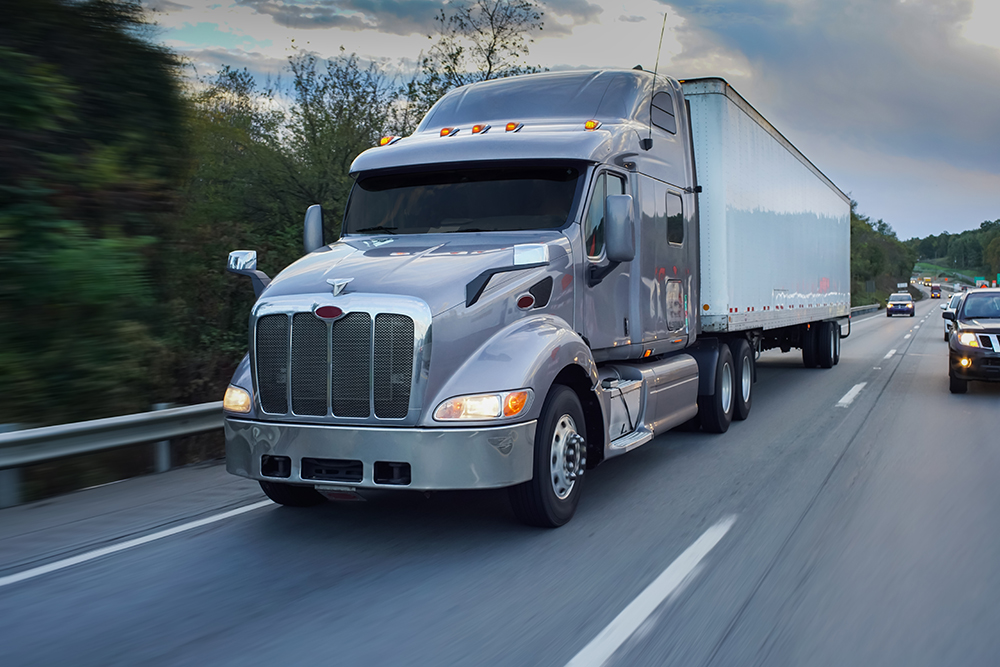How Fast Can Commercial Trucks Safely Travel on Highways?
Most roads across the United States have posted speed limits; however, as you likely know, it doesn’t mean it’s always safe to drive that fast under any and all circumstances. A wide range of factors, including traffic congestion, inclement weather, and how well-maintained a vehicle is, are just some of the many factors that may determine whether it’s safe to travel at a certain rate of speed.
If you’re wondering how the above-referenced factors affect how fast a commercial truck can safely travel on highways, read on for more details. Our team of Las Vegas truck accident attorneys deep-dive into the ways in which they do this below, which is the knowledge you can hopefully use to keep yourself safe when sharing the road with big rigs.
How Are Speed Limits Set?
Speed limits aren’t set as arbitrarily as one may think, per information published by the Federal Motor Carrier Safety Administration (FMCSA). Instead, the federal agency contends that engineering studies dictate what speed limits will be on our nation’s roadways. Some broader factors considered include:
- Roadway characteristics
- Traffic volume
- Operating speeds
- Accidents reported
As you might have guessed, state or local governments, like counties, set speed limits for non-interstates or U.S. highways located within their jurisdictions. Some more specifics or additional factors these agencies weigh when imposing certain speed limits include:
- Numbers of vehicles, pedestrians, and bikes on the roadways
- The presence of road features such as the number of lanes, hills, or curves
- Roadway type (i.e., city street versus interstate)
- Visibility drivers can see in front of them
- Whether there’s on-street parking
- Whether there are any intersections or driveways
- The quality of the pavement in the area
- Whether the area is largely residential or commercial
- Whether there are school or construction zones in an area
What Is the Maximum Speed Limit for Trucks in Nevada?
Posted speed limits in Nevada are highly dependent on where you are driving. Many neighborhoods have speed limits as low as 15 or 20 mph, while some freeways allow cars to travel as fast as 80 mph. Commercial motor vehicles (CMVs) like tractor-trailers and semis face greater scrutiny and limitations when traveling through our state, though. Big trucks are limited to traveling at a speed of no more than 75 mph on highways and rural freeways.
Why Do Speed Limits Matter?
Data published by the National Highway Traffic Safety Administration (NHTSA) shows that the faster a motorist is traveling when a road hazard enters their path, the longer it is likely to take for them to:
- Notice (and register) the potential danger that lies in front of them and apply their brakes
- Reach a full stop after braking
Those same statistics show that for passenger cars driving in optimal road conditions, it can take them the distance of a football field (300 feet) to reach a full stop if the operator applies the brakes while traveling at 55 mph. In contrast, it takes about one-half the distance of a football field for a passenger car driver to stop their vehicle when operating it at nearly one-half that speed (at 30 mph).
Other data shows that while it may take a passenger car driver 300 feet to reach a full stop when traveling at 55 mph, it would typically take a trucker traveling at the same rate of speed with a fully loaded trailer double that amount (600 feet) to do the same.
What Speed Is Safe for Truckers To Travel At?
In this piece thus far, we’ve mentioned how there’s no planned consistency between speed limits from state-to-state, but that they’re contingent upon a wide variety of factors. We’ve also pointed out how braking distance is starkly different between cars and trucks. So, where does that leave us in terms of what’s a safe speed for tractor-trailer operators to drive their 18-wheelers? It comes down to a few different factors we hinted at earlier in this piece, plus a few more, such as:
- Inclement weather: Truckers’ braking distances increase when roads are covered by rain, ice, or snow. Thus, a trucker needs to proceed a bit slower than the posted limit when these conditions are present to ensure they have an adequate ability to brake in time to avoid becoming involved in a crash.
- Loads matter: How full a trailer is and how well-secured the load is within the trailer can extend braking distances or cause such an imbalance in weight that it causes the truck to roll over.
- Road conditions: Potholes, graded (gravely) roads versus freshly paved ones, oil slicks, uneven pavement, and shifting or narrowed lanes due to road construction barriers being erected are only a few of many examples of road situations that may impact a trucker’s ability to operate their tractor-trailer safely at the posted speed limit.
- Traffic congestion: As we know, some roadways are busier at certain times of the day compared to others, with both other automobiles and pedestrian or bike traffic, for example. Of course, a situation where there’s bumper-to-bumper traffic due to rush hour or an accident ahead is going to warrant a trucker driving much more slowly than the posted limit. So too, will the presence of a lot of pedestrians or bicyclists.
- Trucker experience: Despite having a commercial driver’s license (CDL), new truckers are largely still learning about their trucks, including how weight and speed affect braking and more. This inexperience warrants truckers traveling at a slower rate of speed as they get their bearings to ensure the safe operation of their truck.
- How well-maintained the truck is: While no tractor-trailer operator should take a truck that is in disrepair (not roadworthy) out on the road, defects or mechanical concerns may not become obvious until they’re out on the road. While it’s ideal in those circumstances for truckers to pull over and stop where they’re at, it’s not always possible. Thus, they should proceed more slowly than the posted limit in those situations.
The factors we’ve listed above are some of many scenarios that may warrant a trucker driving slower than the posted speed limit to ensure they’re protecting themselves and others from harm.
What Types of Accidents Can Occur if Truckers Exceed Safe Speed Limits?
There is a wide range of collisions that occur if a trucker fails to travel at a safe speed limit, including some of the following types of crashes:
- Rollover accidents: A rollover may occur if a trucker takes a curve too fast and there’s a shift in weight within their trailer because their load is improperly secured in place.
- Tire blowouts: These may occur if a trucker brakes suddenly on already worn-out tires or ones that have changed in terms of consistency due to extreme weather conditions, causing them to burst.
- Rear-end accidents: A rear-end accident may occur if a trucker fails to give themselves adequate time to reach a full stop, resulting in them crashing into the person ahead of them.
- T-bone crashes: A trucker who is speeding may not be able to stop in time to avoid proceeding through an intersection and crashing into those in their path, causing a T-bone accident.
- Front-end accidents: A trucker who is speeding may lose control of their truck, causing them to travel into oncoming traffic and cause a head-on truck crash.
- Jackknife accidents: A trucker who is driving too fast for conditions may not find that applying the brakes in those slippery road conditions is as effective as it otherwise typically is, and the tractor and trailer may become misaligned, causing a jackknife accident.
As you can tell, the speed a truck travels at is a serious matter in that it’s directly tied to the operator’s ability to slow their vehicle to avoid potentially causing a crash.
What To Do if You Believe a Trucker’s Speed Led to Your Crash
You’ve likely heard the saying, “speed kills.” That phrase applies to all types of drivers; however, considering how most passenger vehicles weigh an average of 4,000 pounds, and 18-wheelers can weigh 20 times that amount (80,000 pounds), the outcome can be far more serious if someone or something is struck by one vehicle versus another.
Our Super Team of lawyers at our multi-state law group, Trucking Injury Law Group, has an extensive track record of advocating on behalf of those who have suffered serious injuries in tractor-trailer accidents. We would like to discuss how your injury crash occurred and the serious impairments you have as a result. Contact us to schedule a free consultation to discuss this and any possible legal remedies available to you to pursue to hold responsible parties liable for their actions that caused your preventable collision and injuries.






